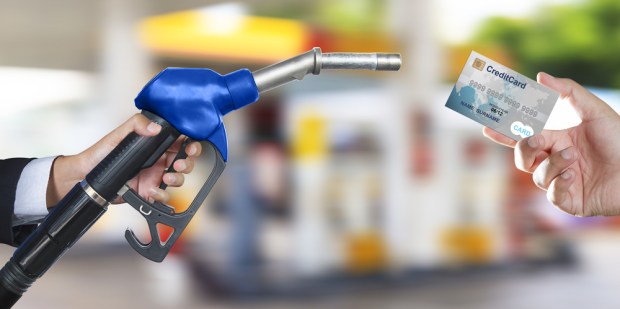Mastercard: Fleet Cards Go High-Tech And Real-Time

When most payments people are talking or thinking about the intersection of things and payments, Mastercard‘s VP of commerce for every device, Matt Miller, noted that their mindset is typically about turning devices that consumers use today – watches, fitness trackers and even appliances – into devices capable of initiating a payment.
It’s only half of the connected-device-turned-payment device story, Miller said in a recent conversation with PYMNTS and Mastercard’s senior vice president, commerce for every device, Kiki Del Valle. Just as exciting, he said, is finding ways to make products work better by payment-enabling them.
And that instinct to make things work better, Del Valle said, is the inspiration behind Mastercard’s new IoT-enhanced fleet management toolset.
Today’s fleet drivers, Del Valle noted, face a cumbersome, inefficient and error-prone process. Drivers pull into the pump, pay with their corporate-issued fleet cards and then manually record their odometer reading and driver ID.
“It’s a recipe for drivers to make errors, and for fleet managers to overspend on fuel,” Del Valle noted, adding that can sometimes even mean the employee “fills up their own fleet vehicle, and then all of their personal lawn care equipment and their best friend’s car to boot.”
Fleet managers know this to be an issue, she said, but it’s one that’s not always easy to spot, or at least to spot quickly. Del Valle said that Mastercard’s fleet management solution integrates the fuel and maintenance data into the payment process once the card is activated by using IoT and tying it directly to the fleet card.
The goal, she said, is to simplify the process for the driver while increasing data and payments transparency for the fleet manager – and to also help the humble fleet card evolve toward bigger and better things within the organizations that use them.
How It Works
Cards issued via Mastercard’s fleet management platform can be issued on a per-driver or per-vehicle basis. Once activated, the card and vehicle data are synced so that each card can be linked to the fleet’s vehicles. When the driver arrives at the pump, the vehicle reports its location, odometer and fuel gauge level.
That data, Del Valle said, will either be recorded and broadcast via the built-in, connected telematics elements within the vehicle, or via a dongle retrofitted for the vehicle’s needs. At that point, the purchase amount is matched to the amount of fuel that was required, if the system detects that overspending has occurred, an alert is sent to both the driver and the fleet manager about the overage.
The driver gets a simpler experience, and is freed from manually recording data on the road. Fleet managers get transparency into their fleet’s spend and have the ability to address potential problems in real time, enabling them to resolve issues where there is apparent overspend, but for a perfectly good reason.
“Some firms do have equipment other than the vehicle itself that requires fuel,” Del Valle said, adding that in such a case, something that appears to be an “overage” can be cleared as a totally legitimate use of the card.
Room for Customization
Giving fleet managers real-time visibility opens new opportunities for them to tailor the program for spend outside of fuel and to replace the more traditional T&E card. That can include a number of new use cases, Del Valle noted, ranging from the care and maintenance of their vehicles to the extension of per diems with set limits on food and lodging expenses – all with built-in controls that keep spending in check.
U.S. Bank will be the first to pilot these new features with its fleet card customers, with a goal of having these features on the road by 2019.
“There is a lot of excitement for finding a [fleet] solution that can bring additional benefits to the industry as a whole,” Del Valle noted.
She is convinced that the internet of things – and connected cars – will be the force that will set this type of fleet card solution into motion, but not only because it makes it easier for drivers to make a fuel purchase.
“This solution isn’t just about enabling a payment in a new way, but by making the fleet card experience more valuable than they’ve been in the past, by connecting those payments to the right data in real time.”
